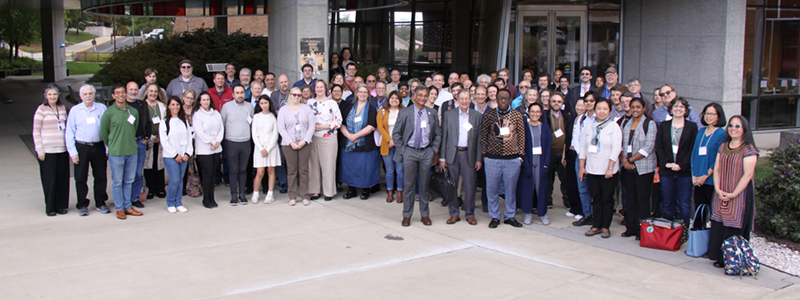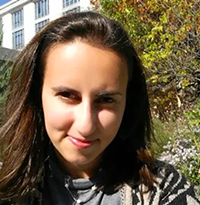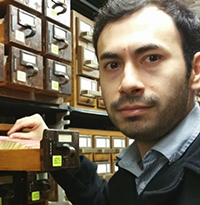- Indico style
- Indico style - inline minutes
- Indico style - numbered
- Indico style - numbered + minutes
- Indico Weeks View
CSAAPT Fall 2023 Semi-Virtual Meeting
→
America/New_York
PSC Lobby (Physical Sciences Complex, University of Maryland, College Park)
PSC Lobby
Physical Sciences Complex, University of Maryland, College Park
4296 Stadium Drive, College Park, MD 20742
Description

This Meeting is hosted and sponsored by the Department of Physics at the University of Maryland, College Park with additional funding from the UVA Department of Physics, the VT Department of Physics, and the VT College of Science.
Overview:
The Fall 2023 Meeting of the Chesapeake Section of the American Association of Physics Teachers (CSAAPT) will be held on Saturday, October 21, 2023 at the University of Maryland College Park.
No membership required!
You do not have to be an AAPT or CSAAPT member to attend. We welcome participation of all physics/science teachers and students in the region (DC, DE, MD, VA and neighboring states) as well as anyone interested in physics education, or physics in general.
The semiannual CSAAPT meetings are a great forum to exchange ideas on novel teaching techniques and economical physics demonstrations, and to meet a fascinating cohort of physics education enthusiasts.
This meeting is semi-virtual. The in-person venue is the Physical Sciences Complex Rooms 0135, 2136, and 3150 at the University of Maryland College Park. See the Meeting Location page for details. The Meeting will be broadcast on Zoom so that people from afar (both presenters and attendees) can join in.
Lodging Support!
We have limited funds to provide up to $350 in lodging support to high school physics teachers. Please see the Travel and Lodging Info page for details.
Program:
- Continental breakfast will be available at the meeting site from 8:00AM. Lunch will also be provided.
- Presentations are expected to start at around 9:00AM and continue until around 5:00PM. (Actual times will depend on the number of abstracts submitted.)
- Timetable will be created after the abstract submission deadline of Saturday, September 30, 2023.
Featured Presentations:
- Prof. Maria Molina (UMD, Department of Atmospheric & Oceanic Science)
Title: Understanding our Changing Climate with Physics and Machine Learning
Abstract: Rising global temperatures related to increased greenhouse gas emissions since the start of the Industrial Revolution are contributing to changes in the Earth system with cascading effects across environments and ecosystems. While observational limitations and feedbacks between integrated system components complicate our ability to model future changes, the field of physics, as applied to the matter that makes up the Earth’s atmosphere, ocean, land, and cryosphere, can help us describe and anticipate the response to changes in the atmosphere’s composition. A strong educational background in introductory physics can lay the needed foundation to tackle many of the challenges related to our changing climate. In this talk, I will discuss the physical basis of our changing climate, why it can be very challenging to characterize certain changes in extreme weather and climate, and what some of the latest research says about these changes. The talk will close with a discussion about the use of machine learning to understand our changing climate and the disproportionate vulnerability faced by historically marginalized communities to extreme weather and climate change.
Bio: Maria J. Molina is an Assistant Professor within the Department of Atmospheric and Oceanic Science at the University of Maryland and an Affiliate Faculty with the University of Maryland Institute for Advanced Computer Studies (UMIACS). She is also affiliated with the National Center for Atmospheric Research (NCAR) in Boulder, Colorado and serves as an Adjunct Assistant Professor within the Department of Marine, Earth, and Atmospheric Sciences at North Carolina State University. Maria is Vice-Chair of the American Meteorological Society (AMS) Committee on Artificial Intelligence Applications to Environmental Science and a member of the AMS Board on Representation, Accessibility, Inclusion, and Diversity (BRAID). Her research group focuses on climate and extremes data science.
- Rebecca Vieyra & Chrystian Vieyra (Vieyra Software)


Title: Do You See What I See?: Smartphones as Visualization Tools
Abstract: Smartphones and other mobile devices can be used to enhance laboratory experiences because of their many internal sensors (accelerometer, gyroscope, light meter, sound meter etc.). During this workshop, use your own device (or borrow one from the presenters!) to cycle through two sets of team-based, data-verified challenges using everyday materials. In the first set of challenges, participants will work in pairs to complete up to seven tasks with Physics Toolbox Play, learning about fundamental physics principles and sensor capabilities. In the second set, participants will use Physics Toolbox LiDAR Motion to match motion graphs using novel LiDAR technology on the iPhone. Finally, participants will have time to brainstorm other ways that they might use smartphones to enhance existing laboratory experiences, from in-the-field data collection experiences to distance learning.
Bios: Rebecca Vieyra is a former high school physics teacher who became a nationally-recognized science educator before serving in roles at the American Association of Physics Teachers, Organization of American States (a diplomatic agency), and PhET Interactive Simulations. Born in central Illinois, Rebecca received her B.S. in Physics Education from Illinois State University and Ph.D. in Science Education from the University of Maryland-College Park. She earned National Board Teacher Certification in 2010, was awarded the Presidential Award for Excellence in Math and Science Teaching by Barack Obama in 2013, and was selected by NASA as an Albert Einstein Fellow in 2014.
Chrystian Vieyra is an Android and iOS app developer with a specialty in sensor data. In addition to working full-time at a major global telecommunications company, he established and continues to develop Physics Toolbox, a suite of apps to advance science education and research that have been used by more than 2 million people since 2013. Born in Celaya, Mexico, he immigrated to the United States to complete his B.S. in Computer Science from Western Illinois University.
Contributed Talks:
We solicit contributions within the following parameters:
- 15-minute talks (12 minute talk + 3-minute Q&A, Both in-person and via Zoom)
Talk topic/demo can be anything pertaining to physics teaching (No student research presentations please unless it is on physics education)
- Demo contribution to Demo Share-a-thon (in the afternoon, in-person only)
Presenters: Sean Lally and Clay Daetwyler from the organizational committee will contact you to organize the event.
Note: A $100 gift certificate from Vernier will go to the best demo-presentation by a high school teacher!
- To submit the title and abstract of your talk/demo, please register first and then click on Call for Abstracts in the menu
- The deadline to submit your title and abstract is midnight of Saturday, September 30, 2023
- Contributors of talks/demos will be issued a certificate of presentation
Registration:
- In-person attendance:
- Please use the in-person attendance registration form on the Registration page,
- The deadline to register for in-person attendance is midnight of Friday, October 13, 2023. This is so that we have a count of how many people will be physically present one week prior to the Meeting.
- In-person attendees are requested the following registration fees to cover administrative and other costs:
- Instructors/faculty of 2-year and 4-year colleges/universities : $25
- K-12 Instructors, Retirees, Students, Guests : $15
- 1st-time in-person attendees : $5
- The registration fee is NOT payable upon registration. A link that will let you pay the registration fee online will be emailed to you after the registration deadline.
- Please use the in-person attendance registration form on the Registration page,
- Virtual Attendance:
- Please use the Zoom attendance registration form on the Registration page,
- The deadline to register for virtual attendance is midnight of Friday, October 20, 2023.
- There is no registration fee for virtual (online) attendance.
- Please note that the Zoom link for the meeting will not be made public and will only be emailed to registrants. This is to prevent Zoom bombing. The Zoom link will be sent to you in a calendar invite, so please pay attention to what you are receiving in your email.
- Please use the Zoom attendance registration form on the Registration page,
- Certificate of Attendance/Presentation:
- Certificates of attendance/presentation will be issued to both in-person and virtual attendees/presenters.
- If you need a certificate of attendance and/or presentation, please register your name exactly as it should appear on your certificate(s). No nicknames or pseudonyms, please.
- A detailed program in pdf can be generated by clicking on the "PDF" button at the top of the "Timetable" page (once the timetable is available).
- Certificates of attendance/presentation will be issued to both in-person and virtual attendees/presenters.
Deadlines:
- Application for Lodging Support: midnight of Friday, September 1, 2023
- Hotel room-block cutoff: midnight of Tuesday, September 5, 2023
- Submission of talk and demo abstracts: midnight of Saturday, September 30, 2023
- Registration for in-person attendance: midnight of Friday, October 13, 2023
- Registration for virtual attendance: midnight of Friday, October 20, 2023
Organizational Committee:
Simone-gunde Kulin (Chair, University of Maryland, College Park, MD)
Muge Karagoz (Co-Chair, CSAAPT Vice President, Assist. Director, Sigma Pi Sigma, AIP, College Park, MD)
Donna Hammer (Co-Chair, University of Maryland, College Park, MD)
Tatsu Takeuchi (CSAAPT President, Virginia Tech, VA)
Clay Daetwyler (University of Maryland, College Park, MD)
Rachele Dominguez (Randolph-Macon College, VA)
James Freericks (Georgetown University, DC)
Edlira Gjikondi (Bethesda-Chevy Chase High School, MD)
Elena Kuchina (Virginia Peninsula Community College, VA)
Sean Lally (Jemicy School, MD)
Samantha Spytek (Rock Ridge High School, VA)
Jason Sterlace (James Madison University, VA)
Angel Torres (University of Maryland, College Park, MD)
Michael Thompson (Thomas S. Wootton High School, MD)
Kent Yagi (University of Virginia, VA)
Participants
Al Tobias
Alejandro Satz
Ales Psaker
Alessandro Restelli
Alice Flarend
ALMA SMITH
Amee Johnson
Amy Liu
Andrea Machella
Andres Akamine
Angel Torres
Antoine Bedard
Aria Heidarian
Athina Meli
Ayden Marhefka
Bob Foley
Brad Conrad
Brad Miller
Brendan Diamond
Bruce Williamson
Carl Mungan
Carter Hall
Christopher Johnson
Chrystian Vieyra Cortés
Connor Wade
Corey Wade
DEBASIS HALDER
Debbie Andres
Dedra Demaree
Deonna Woolard
Digesh Raut
Donna Hammer
Doug McNally
Edlira Gjikondi
Elena KUCHINA
Elissa Levy
Elizabeth Kennedy
Emily Mercurio
Francesca Viale
Gail Wyant
George Murray
Gordon Gainer
Harold Williams
Heather Hough
James DeGrandis
James Freericks
James Stickler
Jan Fiala
Jason Sterlace
Jason Tran
Jency Sundararajan
Jennifer Ayers
Jennifer Groppe
John Casserino
John Makous
John Paulenich
John Yore
Judson Wagner
Kausik Das
Kent Yagi
Lewis McIntyre
Ligaya Diculen
Lilian Clairmont
Maria Molina
Marija Raskovic
Mark Esrick
Mark Jensen
Mary Beth Mackerney
Matthew Hilsdorf
Michael Day
Michael Thompson
Mirela Fetea
Misha Jones
Mohammad Nouristani
Muge Karagoz
Mukesh Chhajer
Murray Korman
Nathan Harshman
Nishchal Thapa Magar
Orlando Toledo
Patrick Banner
Patrick Stanley
Peggy Mallette
Phuc Tran
Qi Lu
Rachel Ivie
Rachele Dominguez
Raymond Fermo
Rebecca Vieyra
Rickey Torrence
Robert Hilborn
Robert Morse
Ronald Freeman
Royce Zia
rudo kashiri
Ryan Fisher
Samantha Spytek
Samanthi Wickramarachchi
Sean Lally
Sehriban Acikgoz
Shane Brogan
Shunsaku Horiuchi
Sovan Acharya
Stephanie Miller
Stephanie Williams
Steve Amann
Sunday Iwalaiye
Tatevik Chalyan
Tatiana Stantcheva
Tatsu Takeuchi
Tehani Finch
Timothy Childers
Timothy McCollum
Wayne Manrakhan
Xiangyun Qiu
Yelena Prok
Yury Antaniuk
- +68

